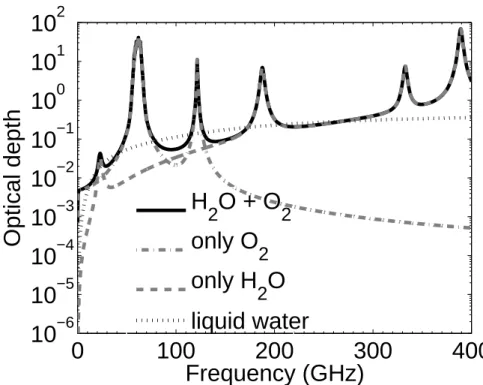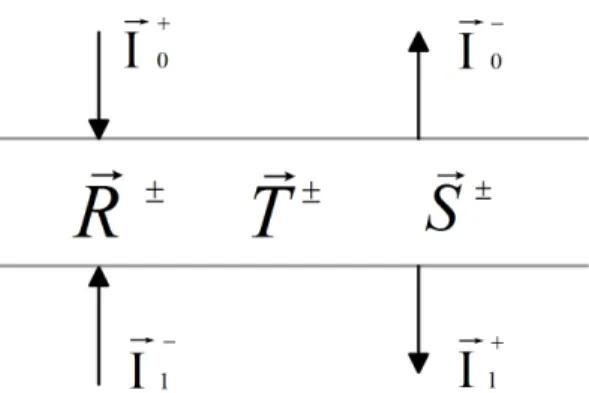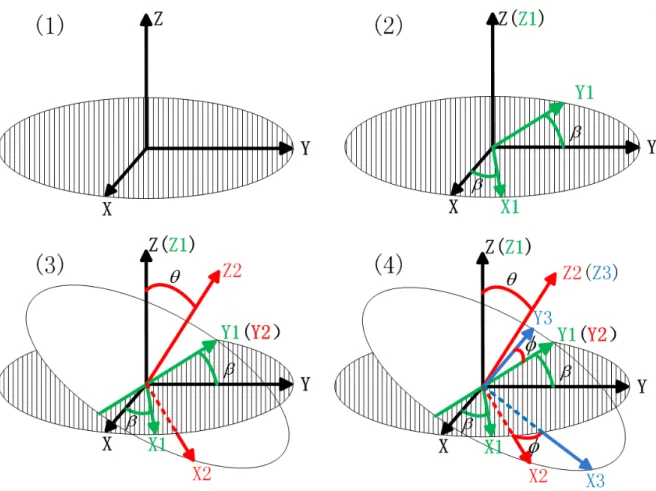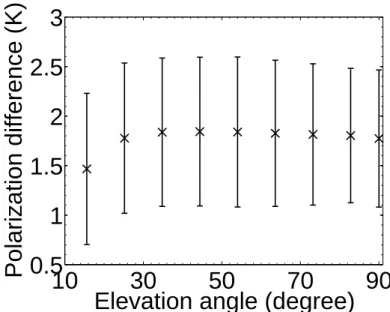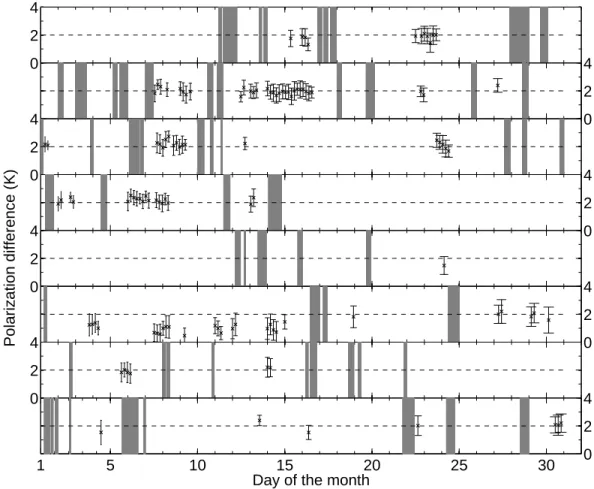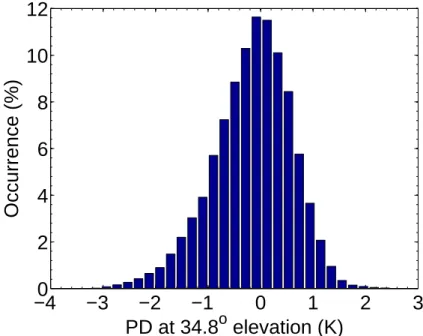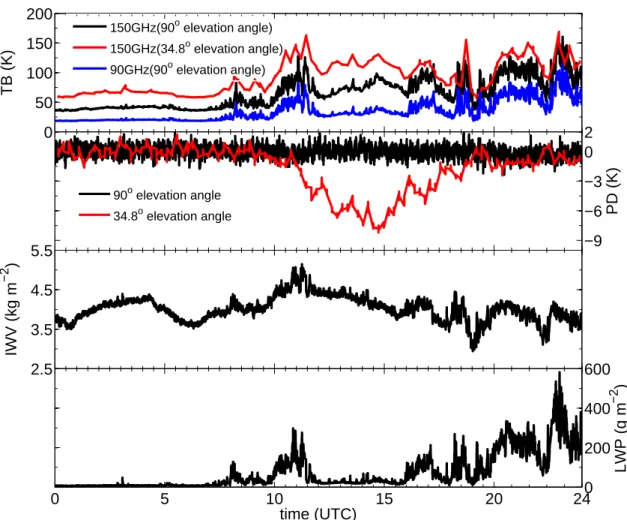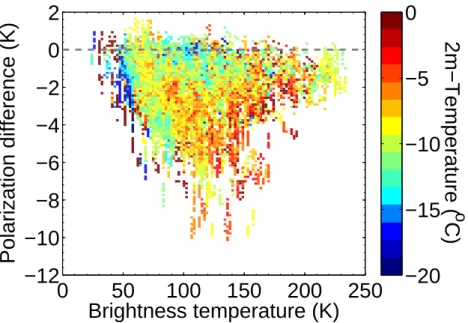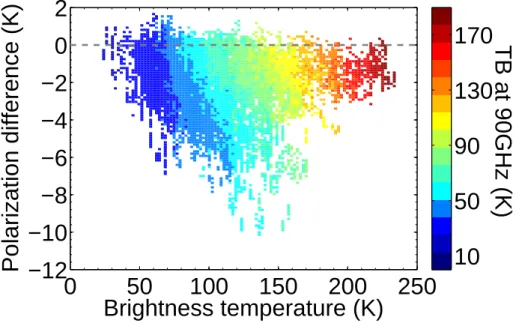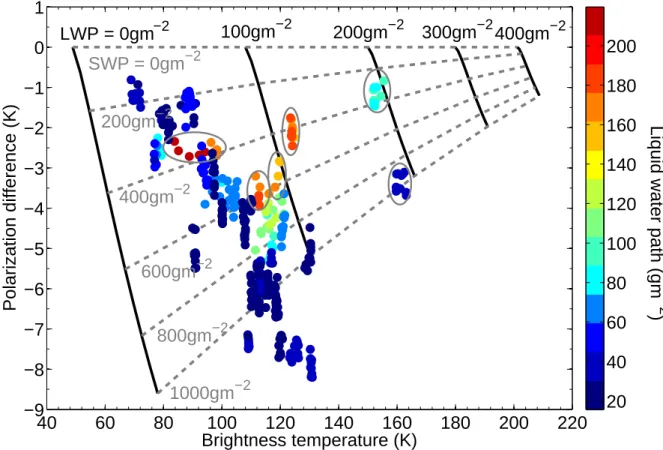Polarized signals from oriented frozen hydrometeors using passive microwave radiometry
Inaugural-Dissertation zur
Erlangung des Doktorgrades
der Mathematisch-Naturwissenschaftlichen Fakult¨at der Universit¨at zu K¨oln
vorgelegt von Xinxin Xie aus Hunan, China
K¨oln 2012
Tag der m¨undlichen Pr¨ufung: 26.06.2012
Abstract
Ice clouds play a significant role in energy budget of the earth-atmosphere system, and they also participate in global hydrological cycle. Thick ice clouds which are associated with precipitation transfer energy and water between the atmosphere and the earth. The net effects of ice clouds on the earth-atmosphere system highly depend on their microphysical properties. However, the complex and variable structure of ice clouds makes it difficult to capture them well in models. The oversimplified microphysical properties of ice clouds in retrievals introduce significant uncertainties in weather and climate studies.
The knowledge on the orientation of ice particles is very limited. The orientation of frozen hy- drometeors which induces polarization signatures determines the magnitude of polarized sig- nals. In order to investigate the potential polarized signatures induced by the oriented frozen hydrometeors, ground-based polarization observations have been performed at “Umwelt- forschungsstation Schneefernerhaus” (UFS) on Mount Zugspitze (German Alps) at 2650 m above sea level. In this study, the polarization observations carried out by a ground-based dual polarized microwave radiometer (DPR) at 150 GHz are investigated together with aux- iliary instruments deployed at UFS, i.e., a second microwave radiometer (HATPRO) and a K-band micro rain radar (MRR). HATPRO measures liquid water path (LWP) and integrated water vapor (IWV) during snowfall, and MRR operating at 24.1 GHz provides indirect snow water path (SWP) information.
Based on the observations, the analysis of a single snow case and one-year snowfall data show that the brightness temperature (TB) differences between the vertical and horizontal polarizations reach up to−10 K at an elevation angle of 34.8◦ during snowfall. The polarized signals during snowfall can be explained well by the occurrence of oriented snow particles. The analysis of the synergic observations shows the effects of snowfall parameters on polarization differences (PDs) observed with DPR at 150 GHz. The dependencies of the measured PD and TB on MRR integrated radar reflectivity and independently derived LWP are discussed.
It shows that the high SWP indicated by high values of MRR integrated reflectivity enhances both TB and PD due to the scattering effects of snow particles. Meanwhile, TBs are found to be enhanced during snowfall when supercooled liquid water is present, while PD resulting from oriented snow particles is damped by the increase of LWP. The polarization observations support the potential role of polarization measurements in improving retrievals of snowfall microphysical parameters.
To evaluate the effects of SWP and LWP on PD and TB, radiative transfer (RT) simu- lations assuming horizontally aligned snow oblates using a polarized RT model have been performed. PD and TB observations can be captured well by the RT model with given rea- sonable assumptions on the microphysical parameters of oriented snow oblates. Additionally, the uncertainties of PD and TB caused by snow microphysical properties are fully examined in the RT simulations. The “damping (enhancing)” effects of supercooled liquid water on
i
PD (TB) are further interpreted by a simple physical model where the height of cloud liquid varies with respect to the dichroic snow layer. From the ground-based observations, it is found that PD resulting from oriented snow particles is absorbed by supercooled liquid below snow layers. When supercooled liquid water is located above snow layers, PD is damped since it is compensated by the emission of supercooled liquid water penetrating the snow layer. TB is generally enhanced by the presence of LWP: the warmer the supercooled liquid water, the larger the TB.
The polarization observations promote the design of new instruments further. Under an as- sumption that ice particles are oriented, RT simulations are performed for the space-borne satellite FengYun-4 (FY-4) channels to examine polarization information content for ice cloud characterization. The results show that polarization can be beneficial for ice cloud retrievals and additional information can be provided by polarized signals to quantify ice cloud param- eters, especially at high frequency channels. Therefore, the present work strongly suggests the deployment of microwave polarization channels for ice cloud observations.
Zusammenfassung
Eiswolken spielen eine wichtige Rolle im Energiehaushalt des Systems Erde-Atmosph¨are und nehmen dar¨uber hinaus auch einen wichtigen Platz im globalen Wasserkreislauf ein. Dicke Eiswolken, welche mit der Niederschlagsentstehung in Verbindung stehen, transportieren Energie und Wasser zwischen Atmosph¨are und Erdboden. Der Netto-Effekt von Eiswolken auf das Erde-Atmosph¨are System h¨angt stark von deren mikrophysikalischen Eigenschaften ab. Jedoch macht gerade die komplexe und variable Struktur der Eiswolken es schwierig diese in Modellen abzubilden. Die stark vereinfachten mikrophysikalischen Eigenschaften von Eis- wolken in Ableitungsalgorithmen f¨uhren daher zu erheblichen Unsicherheiten in Wetter- und Klimastudien.
Unser Wissen ¨uber die Orientierung von Eispartikeln ist sehr begrenzt. Die Orientierung von gefrorenen Hydrometeoren, welche polarisierte Signale erzeugen k¨onnen, bestimmt maßgeb- lich die St¨arke der Polarisierung. Um das Potenzial polarimetrischer Signale zu untersuchen, welche durch gefrorene Hydrometeore verursacht werden, wurden bodengebundene polari- metrische Messungen an der Umweltforschungsstation Schneefernerhaus (UFS) unterhalb der Zugspitze (Deutsche Alpen) auf 2650 m H¨ohe (NN) durchgef¨uhrt. Im Rahmen dieser Studie wurden polarimetrische Beobachtungen bei 150 GHz von einem boden-gebundenen Dual Polarized Microwave Radiometer (DPR) zusammen mit zus¨atzlichen Instrumenten, welche auf der UFS installiert waren untersucht. Diese zus¨atzlichen Instrumente bestanden u.a.
aus einem zweiten Mikrowellenradiometer (HATPRO) und einem Mikro-Regenradar (MRR) welches im K-Band arbeitet. Mit HATPRO k¨onnen der vertikal integrierte Fl¨ussigwassergehalt (LWP) sowie der integrierte Wasserdampfgehalt (IWV) w¨ahrend Schneefall gemessen werden, w¨ahrend das MRR, welches bei 24.1 GHz betrieben wird, eine indirekte Information ¨uber den vertikal integrierten Schneewassergehalt (SWP) liefert.
Basierend auf diesen Beobachtungen ergaben die Analysen eines einzelnen Schneefallereignisses sowie des gesamten einj¨ahrigen Schneefalldatensatzes, dass die Unterschiede in den Strah- lungstemperaturen (TB) zwischen vertikaler und horizontaler Polarisationsrichtung w¨ahrend Schneefall bis zu −10 K bei einem Elevationswinkel von 34,8◦ betragen. Die Polarisations- signale w¨ahrend der Schneefallereignisse k¨onnen durch das Auftreten von orientierten Schnee- partikeln erkl¨art werden. Zusammen mit den anderen Beobachtungen zeigte die Unter- suchung den Einfluß der verschiedenen Schneefallparameter auf die Polarisationsdifferenzen (PDs) bei 150 GHz welche mit dem DPR gemessen wurden. Außerdem werden in dieser Arbeit die Abh¨angigkeiten der gemessenen PD und TB von der mittels MRR gemessenen integrierten Radarreflektivit¨at und dem unabh¨angig abgeleiteten LWP diskutiert. Es zeigt sich, dass die hohen SWP Werte, angezeigt durch hohe Werte der vom MRR gemessenen integrierten Radarreflektivit¨at, durch Streueffekte an den Schneepartikeln zu erh¨ohten TB und PD f¨uhren. Die TBs sind ebenfalls erh¨oht bei Schneefallereignissen, welche unterk¨uhltes Fl¨ussigwasser enthalten. Im Gegensatz dazu, werden die PDs, hervorgerufen durch orientierte
iii
Schneepartikel, durch zunehmende LWP Gehalte ged¨ampft. Die Polarisationsbeobachtungen best¨atigen daher das Potenzial polarisierter Beobachtungen f¨ur die Verbesserung der Ableitung mikrophysikalischer Schneefallparameter.
Um die Effekte von SWP und LWP auf die PD und TB genauer zu untersuchen, wurden Strahlungstransportsimulationen (RT) mit einem polarisierten Strahlungstransportmodell und horizontal orientierten Schnee-Ellipsoiden durchgef¨uhrt. Die beobachteten Werte von TB und PD k¨onnen unter Annahme realistischer Werte f¨ur die mikrophysikalischen Eigenschaften der Schnee-Ellipsoide gut durch die RT-Simulationen wiedergegeben werden. Ebenfalls wur- den die Unsicherheiten der TB und PD, welche durch die variablen mikrophysikalischen Schneefalleigenschaften verursacht werden, eingehend mittels RT Simulationen untersucht.
Der ”d¨ampfende (erh¨ohende)” Effekt des unterk¨uhlten Fl¨ussigwassers auf die PD (TB) wurde weitergehend mittels eines einfachen physikalischen Modells ¨uberpr¨uft, bei dem die H¨ohe der Fl¨ussigwasserschicht in Bezug zur Schneefallschicht variiert werden kann. Bodengebundene Beobachtungen ergaben, dass die durch orientierte Schneepartikel hervorgerufenen PD von Fl¨ussigwasserschichten unterhalb der Schneefallschicht absorbiert werden. Wenn die un- terk¨uhlte Fl¨ussigwasserschicht sich hingegen ¨uber der Schneefallschicht befindet, f¨uhrt dies zu einer D¨ampfung der PD, da es durch die Emission des unterk¨uhlten Fl¨ussigwassers, welches die Schneefallschicht durchdringt, kompensiert wird. Die TB werden jedoch grunds¨atzlich durch das Vorhandensein von unterk¨uhltem Fl¨ussigwasser erh¨oht: Je w¨armer das unterk¨uhlten Fl¨ussigwasser dabei ist, desto h¨oher sind die korrespondierenden TB.
Die Polarisationsbeobachtungen best¨arken die Entwicklung neuer Messinstrumente. Unter der Annahme orientierter Eispartikel wurden RT Simulationen f¨ur die Frequenzkan¨ale des Satelliten FengYun-4 (FY-4) durchgef¨uhrt um den Informationsgehalt polarisierter Messungen f¨ur die Charakterisierung von Eiswolken zu untersuchen. Die Ergebnisse zeigen, dass Polari- sationsmessungen wertvoll sein k¨onnen f¨ur Ableitungsalgorithmen von Eiswolken. Besonders bei den hochfrequenten Frequenzkan¨alen k¨onnen Polarisationsmessungen zus¨atzliche Informa- tionen liefern um Parameter von Eiswolken zu quantifizieren. Ausgehend von den Ergebnissen der hier vorgestellten Arbeit ist es deshalb ¨außerst empfehlenswert f¨ur die Beobachtung von Eiswolken polarisierte Mikrowellenempf¨anger einzusetzen.
Contents
1 Introduction 1
1.1 Motivation . . . . 1
1.2 State-of-the-art . . . . 3
1.2.1 Microwave remote sensing of frozen hydrometeors . . . . 3
1.2.2 Polarization radiation observed by microwave radiometers . . . . 6
1.3 Focus of the study . . . . 8
2 Methodology 11 2.1 Definition of terminology in radiative transfer . . . . 11
2.1.1 Basic radiative parameters . . . . 11
2.1.2 Polarization and Stokes parameters . . . . 12
2.1.3 Radiation interactions in the atmosphere . . . . 15
2.2 Radiative transfer theory . . . . 20
2.2.1 The polarized radiative transfer equation . . . . 20
2.2.2 Solution to the polarized radiative transfer equation . . . . 21
2.3 Scattering properties of particles . . . . 23
2.3.1 T-matrix method . . . . 24
2.3.2 DDA algorithm . . . . 25
3 Instrumentation and data set 29 3.1 Instrumentation . . . . 29
3.1.1 Microwave radiometer: DPR . . . . 29
3.1.2 Microwave radiometer: HATPRO . . . . 30
3.1.3 Micro rain radar . . . . 32
3.1.4 Additional instruments . . . . 32
3.2 DPR PD bias correction . . . . 32 v
4.2 Statistical analysis in 2010 . . . . 39
4.3 Conclusions . . . . 43
5 RT simulations during snowfall 45 5.1 Case study: 4 April 2010 . . . . 45
5.1.1 RT setup . . . . 45
5.1.2 RT results . . . . 47
5.2 Sensitivity of PD and TB to snow parameters . . . . 50
5.2.1 Aspect ratio . . . . 51
5.2.2 Particle canting angle . . . . 53
5.2.3 Mass size relationship . . . . 55
5.2.4 Other parameters . . . . 60
5.3 Explanations of supercooled liquid water effects on PD and TB . . . . 61
5.3.1 With or without supercooled liquid water . . . . 61
5.3.2 Locations of supercooled liquid water . . . . 65
5.4 Conclusions and remaining uncertainties . . . . 69
5.5 Implications of PD for snowfall retrievals . . . . 70
6 Potential of PD information for ice cloud detection 73 6.1 FY-4 description . . . . 73
6.2 RT simulations at FY-4 window channels . . . . 74
6.2.1 RT setup . . . . 74
6.2.2 Ice particles with horizontal orientation . . . . 76
6.2.3 Ice particles with canting angles . . . . 78
6.3 Conclusions . . . . 80
7 Summary and outlook 85
List of acronyms 89
List of symbols 91
Bibliography 93
Chapter 1
Introduction
Ice clouds which regularly cover at least 20% of the globe profoundly affect global weather and climate systems (Liou, 1986; Wylie et al., 1994). They play an important role in the energy budget of the earth-atmosphere system, since ice clouds can reflect short and long wave radiation and emit long wave thermal radiation to the earth-atmosphere system (Liou, 1986).
The net radiation effect caused by ice clouds strongly depends on their radiative properties, such as, spacial distribution, ice water content, microphysical properties of ice particle, etc.
(Buehler et al., 2007). Thick ice clouds, which are regarded to be associated with frozen precipitation (e.g., falling snow), are quite important for energy and water transfers between the earth and the atmosphere. The typical high albedo of snow cover on the surface reflects solar radiances back to the atmosphere and warms the surface air temperature (the so- called “snow-albedo feedback”) (Armstrong and Brun, 2008). The frozen precipitation which originates from ice clouds transports water between the earth and the atmosphere is an important component in hydrological cycle of the globe.
The importance of ice clouds for weather and climate has been recognized in previous stud- ies (e.g., Buehler et al., 2007; Stephens and Kummerow, 2007; Armstrong and Brun, 2008).
However, the variable structure of ice clouds in time and space makes it extremely difficult to characterize them properly. The simplifications of microphysical properties of ice clouds give rise to substantial uncertainties in weather and climate modelings (Protat et al., 2010).
Therefore, it becomes important to better understand and represent ice clouds in observations and models.
1.1 Motivation
Ground-based and space-/air-borne microwave radiometry has shown promising ability in ice cloud observations (e.g.,Evans et al., 2002;Kneifel et al., 2010;Skofronick-Jackson and Johnson, 2011). Compared to visible and infrared remote sensing, microwave radiation can penetrate most clouds and thus provides an insight into vertical profiles of ice clouds. Moreover, the wavelength in the microwave spectrum is comparable to the size of the frozen hydromete- ors ranging from several microns to several millimeters and the sensitivity of microwave to ice particles is considerably high (Jim´enez et al., 2007; Wu et al., 2008). Accordingly, mi- crowave radiometry has been recognized as one of the most efficient and important approaches to observe ice clouds (Wang et al., 2001; Skofronick-Jackson et al., 2004; Wu et al., 2006).
The sensitivities of microwave channels to hydrometeors in the frequency range from 1 GHz 1
to 1000 GHz have been thoroughly investigated in previous studies (e.g., Gasiewski, 1992;
Evans and Stephens, 1995b). They showed that observations with microwave channels, espe- cially those at higher frequencies (≥90 GHz), are able to derive microphysical parameters of frozen hydrometeors.
Ice particles occur in clouds when the temperature is below 0◦C, and the probability of ice particles being present increases as the temperature decreases (Wallace and Hobbs, 2006).
Frozen hydrometeors can grow at the expense of water vapor in the vicinity. When ice particles collide with water droplets or ice particles, their growth by aggregation or riming makes their shapes more irregular (Wallace and Hobbs, 2006). Observations show that ice clouds are composed of a large number of nonspherical frozen hydrometeors. Common crystal types in ice clouds are predominantly categorized into be platelike, columnlike and irregular ice particles (Heymsfield, 1972;Noel and Sassen, 2005).
The knowledge on the microphysics of ice clouds is still limited. The oversimplifications of ice cloud microphysics in models produce significant uncertainties in the meteorological and climatological studies (Kim et al., 2008; Protat et al., 2010). Specially, the orientation of frozen hydrometeors is one of the important components which pose significant impact in the retrievals. Most analysis on ice clouds, either in radiative transfer models or retrieval algo- rithms, assumed that frozen hydrometeors are spherical or randomly oriented (Evans et al., 2005; Grecu and Olson, 2008; Kim et al., 2008; Kneifel et al., 2010). The study by Ono (1969) suggested that ice crystals in clouds tend to fall with their maximum dimension par- allel to the ground. Pristine ice particles have been found to fall with their largest dimension horizontally oriented (Pruppacher and Klett, 1997). In the past decades, observations in the visible and near infrared spectral range have verified that ice particles have preferential ori- entation (Chepfer et al., 1999; Noel and Chepfer, 2004; Noel and Sassen, 2005). However, for large particles, it becomes difficult to define their preferential orientation, especially for frozen hydrometeors with complex habit, e.g., aggregates. Their orientation also increasingly depends on the local aerodynamic conditions.
Thus, it is still unclear,
whether frozen particles in ice clouds and during precipitation are orientated or not,
to which extent they can cause polarization signals in ground-based and space-/air-borne observations if frozen hydrometeors are oriented,
how polarized signals improve ice cloud retrievals when ice particles produce significant polarization signatures during their falling process.
In order to solve these specific questions concerning ice particle orientation, ground-based po- larization observations have been conducted at “Umweltforschungsstation Schneefernerhaus”
(UFS) in Germany, by means of a dual polarized microwave radiometer at the frequency of 150 GHz (L¨ohnert et al., 2011). UFS on Mount Zugspitze offers a unique perspective for the observations of ice clouds and snow precipitation. It is located at 2650 m above mean sea level (MSL) and the occurrences of snow events are much more frequent, comparing to observation sites at lower altitudes. The polarization observations at UFS are dedicated to gain insight into the polarization signatures originating from oriented frozen hydrometeors.
The study aims to investigate the potential role of the polarization signatures caused by orientated frozen particles in determining their microphysical parameters.
1.2. State-of-the-art 3 The unique study on polarization observations may further promote the design of new space- borne instruments for ice cloud observations. In contrast to ground-based remote sensing, observations from space require much lighter but more reliable instruments. It is unknown whether polarized channels should be aboard satellites or not, since the existence of orientated ice particles and the benefits of polarization observations have not been clarified so far. New satellite sensors at submillimeter waveband (microwave frequency ≥ 300 GHz) have been proposed for ice cloud characterization in the past few years (e.g.,Buehler, 2005). Meanwhile, in China a second generation of geosynchronous satellite FengYun-4 (FY-4) also aims at ice cloud observations. One of the advantages of space-/air-borne remote sensing is that, the surface contribution is negligible due to the strong absorption of water vapor near the surface, especially in the so-called submillimeter-wave spectrum. Thus, observations from space at high frequencies have significant contributions from ice clouds. The analysis on polarization observations could be valuable for the retrievals of ice clouds. The polarization information provided by oriented frozen hydrometeors will be determinative for the additional polarization channels of space-borne instruments.
1.2 State-of-the-art
1.2.1 Microwave remote sensing of frozen hydrometeors
Because of the important role of ice clouds in energy budget and hydrological cycle of the earth-atmosphere system, there is an increasing interest in retrieving ice clouds (Evans and Evans, 1999; Buehler et al., 2007). To develop retrieval algorithms, it is crucial to understand the radiative interactions in the atmosphere which physically relates the observations to physical properties of ice clouds.
The basic principle of radiative interaction in the atmosphere can be described as follow. In the presence of scattering (absorbing) medium in the atmosphere, the radiation propagating through the medium is scattered (absorbed and re-emitted) to all directions. For liquid- phased hydrometeors, their emission effects dominate the observed radiances by microwave radiometers (Battaglia and Simmer, 2007), while the scattering effects are the predominant process for frozen hydrometeors, like ice and snow particles, especially at high microwave fre- quencies (Gasiewski, 1992; Evans and Stephens, 1995a;Noh, 2006). From the ground-based perspective, the scattering/absorption effects of clouds and precipitating hydrometeors en- hance the radiances received by upward looking instruments below the atmospheric medium, while they reduce the observed radiance for downward viewing sensors which are located above the medium. The magnitude of the received radiances strongly depends on the radia- tive characteristics of ice clouds and precipitation systems (e.g., Bennartz and Petty, 2001;
Kim et al., 2008). Therefore, the observation which results from scattering/absorption pro- cesses is employed to derive the microphysical properties of clouds and precipitation, e.g., ice water path (IWP) and particle effective size, either from ground-based or space-borne instruments (e.g., Grecu and Olson, 2008; Kim et al., 2008; Defer et al., 2008). Moreover, while microwaves can probe clouds with high IWP, visible and infrared waves are saturated within the clouds. Since microwave observations are generally sensitive to hydrometeors es- pecially at high frequencies, they are applicable to detect the vertical structure of ice clouds (Cordisco et al., 2006; Noh, 2006).
The weak signals at microwave frequencies lower than 90 GHz make observations of frozen hydrometeors move to a higher frequency. Considering small crystals in high level ice clouds,
the submillimeter-wave cloud ice radiometer (SWCIR) developed by the Jet Propulsion Labo- ratory (JPL) was designed for ice cloud observations with channel frequencies up to 643 GHz.
The accuracy of the employed retrieval algorithm is assumed to be∼30% for the integrated ice amount and ∼15% for the median mass equivalent sphere diameter (Evans et al., 2002).
The compact scanning submillimeter imaging radiometer (CoSSIR) was first deployed for the regional study of tropical anvils and cirrus layers Florida area cirrus experiment (CRYSTAL- FACE) in 2002 (Evans et al., 2005). The observations of CoSSIR in CRYSTAL FACE verified that submillimeter-wave channels have higher sensitivity to ice particle size, compared to the lower frequencies. Another submillimeter-wave instrument for ice cloud measurements has been recently proposed by Buehler (2005): the cloud ice water path submillimetre imaging radiometer (CIWSIR). Theoretically, the CIWSIR could retrieve the IWP with an accu- racy of ∼20% and the median mass equivalent sphere diameter with an accuracy of ∼30 µm (Buehler et al., 2007). From an active perspective, the observations from the Cloud- Sat satellite carrying with a 94 GHz radar (Stephens et al., 2002) and the Cloud-Aerosol Lidar and Infrared Pathfinder Satellite Observation (CALIPSO) (Winker et al., 2010) pro- vide important information for retrieving the microphysical properties of ice clouds (e.g., Delano¨e and Hogan, 2010).
Going on to thick ice clouds, these clouds are usually associated with precipitation pro- cesses, like falling snow. Radar provides valuable information on these clouds as well as on thin ice clouds. They were used to characterize frozen hydrometeors (e.g., Hogan et al., 2006; Matrosov, 2007). The amount of radiance scattered backwards from ice hydromete- ors depends on their microphysical properties, i.e., size distribution, particle size, shape, density, composition and orientation (Collier, 1989). Some microphysical parameters of frozen hydrometeors, like precipitation rate and ice water content (IWC), have been predicted based on the radar reflectivity in previous studies (e.g., Hogan et al., 2006; Matrosov, 2007;
Grecu and Olson, 2008; Hogan et al., 2012). However, the variability of microphysical prop- erties of frozen hydrometeors in ice clouds and during precipitation results in significant vari- ations in the relations between the radar reflectivity and precipitation rate (Levizzani et al., 2011).
Synthesizing observations of active and passive microwave remote sensing shows noticeable performance in frozen hydrometeor retrievals (Grecu and Olson, 2008;Kim et al., 2008). Us- ing the Bayesian retrieval algorithm associated with advanced microwave sounder unit-B (AMSU-B) observations,Kim et al.(2008) reported that the retrieved snowfall rate was con- sistent with the radar measurements. The retrieval algorithm which combined the radar data with the microwave radiometer measurements showed its application to the actual observa- tions, although the estimation on the microphysics of frozen hydrometeors can cause a bias in the retrieval (Grecu and Olson, 2008).
The accuracy of retrieval algorithms are all associated with the necessary assumptions on microphysical parameters of frozen particles, both for passive and active remote sensing.
Realistic representation of frozen particles in models could be of peculiar help to improve the accuracy of retrievals. The vertical structure of frozen hydrometeors is also required in order to quantify ice clouds (Levizzani et al., 2011). However, on the one hand, the complex microphysics of frozen hydrometeors make it difficult to model them accurately. On the other hand, the lack of information on their microphysics greatly hamper the accuracy of ice cloud retrievals. No observations can offer enough information to retrieve all the parameters.
Therefore, an optimization of microphysical parameters of frozen hydrometeors are necessary to improve the retrieval algorithms.
1.2. State-of-the-art 5 In the following, microphysical properties of ice clouds, which have significant impact on radiative properties of frozen hydrometeors, are addressed on the basis of the present studies.
Ice permittivity
The complex permittivity of pure ice, which depends on many factors, is one of the de- terminative factors for ice scattering properties, and it is difficult to obtain the true value of permittivity of ice particles in clouds. Jiang and Wu (2004) updated Hufford’s model (Hufford, 1991) for radiative transfer calculations for microwave limb sounders (MLS). They found that the uncertainties in the real and imaginary parts of ice permittivity result in errors in extinction coefficients and single scattering albedo at a typical particle size at the upper atmosphere research satellite (UARS) and earth observing system (EOS) MLS ra- diometer frequencies (Jiang and Wu, 2004). Employing another model for ice permittivity (M¨atzler and Wegm¨uller, 1987), Kim (2004) calculated the extinction and absorption cross sections and asymmetry factors for spherical crystals, based on 20% uncertainty in the imag- inary part of complex permittivity. The uncertainties of ice permittivity lead to a 3% uncer- tainty in both extinction efficiencies and asymmetry factors, for size parameters less than 12 at the frequency of 340 GHz. An uncertainty of 5% in the real part of permittivity resulted in more than 5% mean deviations in both scattering and extinction efficiencies, especially significant at high frequencies (183 GHz). The absolute variations of the emerging brightness temperature (TB) from ice clouds due to uncertainties in the permittivity were found to be more than 1 K (Xie et al., 2009).
Ice particle shape
Traditionally, hydrometeors are assumed to be spherical in radiative transfer models and retrievals (e.g., Skofronick-Jackson et al., 2002; Evans et al., 2005). Studies begin to treat ice particles with more realistic shapes in the past years, like columns, plates and aggre- gates (Kim et al., 2008; Kneifel et al., 2010), since scattering properties of nonspherical ice particles can be calculated by solving the electromagnetic equations (Draine and Flatau, 1994;Yang and Liou, 1996;Bohren and Huffman, 1998;Mishchenko et al., 2002). Databases for single scattering properties of randomly oriented particles are available (e.g., Liu, 2008;
Hong et al., 2009). The effect of nonspherical habits on radiance is further investigated, e.g., Bennartz and Petty (2001);Kneifel et al.(2010). Varying ice particles, from dendrites to bul- let aggregates, brings forth differences of TB on the order of 20 K at 150 GHz (Kneifel et al., 2010).
Ice particle mass size relationship
The different particle densities lead to different particle mass size relationships, and further results in different relations between IWC and radar reflectivity (e.g., Brown and Francis, 1995; Matrosov, 2007;Heymsfield et al., 2010). Radar reflectivity and precipitation rate re- lations are found to vary with temperature, since the riming process during snowfall po- tentially changes the mass size relationships (Matrosov, 2007). Assuming ice-air mixed oblates, Hogan et al. (2012) compared two different mass size relationship of ice particles, i.e., Brown and Francis (1995) and Heymsfield et al. (2010), and they found that the high particle density results in an overestimation of IWC retrieved from radar reflectivity.
Ice particle size spectrum
It was shown that the hydrometeors sizes follow an exponential size distribution (Marshall and Palmer, 1948; Field et al., 2005). Field et al.(2005) proposed a universal size distribution of ice par-
ticles based on aircraft measurements. They expressed intercept parameter in size spectra
as a function of the atmospheric temperature. The variability in ice particle size spectrum leads to considerable uncertainties in passive and active remote sensing (Hogan et al., 2006;
Kneifel et al., 2010), since scattering ability of frozen hydrometeors varies with their size (e.g., Liu, 2008).
Supercooled liquid water in ice clouds
Significant amounts of supercooled liquid water were frequently found in ice cloud observa- tions, even at very low temperatures (L¨ohnert et al., 2011). The emission of supercooled liquid water has an impact on the observed radiances, especially at high frequencies. How- ever, the radiative properties of supercooled liquid water is not completely understood due to the lack of laboratory measurements of its refractive index (M¨atzler et al., 2010;Cadeddu, 2011). This makes ice cloud retrievals much more difficult when ice particles coexist with supercooled liquid water (Levizzani et al., 2011).
Ice particle orientation
So far, ice particles are assumed to be randomly oriented in most studies. However, the preferential orientation enhances the scattering effects of frozen hydrometeors. Therefore it affects the brightness temperature depression (Xie and Miao, 2011) and enhances radar reflectivity (Sun et al., 2011). Meanwhile, from the passive perspective, oriented frozen hy- drometeors result in TB difference between the vertical and horizontal polarizations (e.g., (Evans and Stephens, 1995b). Thus, RT simulations were done to investigate the poten- tial of polarization observations from space for ice cloud characterization (Miao et al., 2003;
Xie and Miao, 2011). By active remote sensing of frozen hydrometeors, Matrosov (2007) and Hogan et al. (2012) found that oriented oblates give better approximations for radar observations than particles with radome orientation.
In contrast to randomly oriented particles, the scattering properties of oriented ice particles, as well as the polarization of the scattered radiation, vary with the incident and scattered directions (Yang et al., 2011). Numerous methods have been developed to calculate scatter- ing characteristics of perfectly or partially oriented nonspherical particles, e.g., Mishchenko (2000). Scattering calculations for oriented ice particles are rare because their orientation is still an open issue, especially for aggregated or rimed particles. With the T-matrix method (Mishchenko, 2000;Mishchenko et al., 2002) and other numerical algorithms (Kahnert, 2003),
e.g., the discrete dipole approximation (DDA) algorithm (Draine and Flatau, 1994;Yurkin and Hoekstra, 2007) and finite-difference time domain method (FDTD) (Yang and Liou, 1996), scattering
properties of oriented snow particles can be calculated principally, though there are still some limitations. The T-matrix method can be used only for particles with a rotational symme- try around a defined axis (Mishchenko et al., 2002), e.g., columns, oblates and Chebyshev particles. The DDA and FDTD methods can be used to calculate scattering characteristics of particles with an arbitrary shape. However, the algorithm is computationally expensive, especially for larger particles at the microwave band (Kahnert, 2003; Draine and Flatau, 2004).
1.2.2 Polarization radiation observed by microwave radiometers
It is known that frozen hydrometeors with preferential orientation have strong dichroism effects which cause polarization difference (PD) between the horizontal and vertical polariza- tions (e.g., Evans and Stephens, 1995b; Miao et al., 2003). Davis et al. (2005) obtained the
1.2. State-of-the-art 7 polarized signals in cirrus clouds at 122 GHz. However, as described above, frozen hydrom- eteors have been assumed to be spherical or randomly-oriented in RT models and retrieval algorithms for decades, and radiation emerging from clouds is considered to be unpolarized (e.g., Evans et al., 2005; Kim et al., 2008; Kneifel et al., 2010). On the one hand, this is for simplification in the models; on the other hand, the orientation of frozen hydrometeors is unknown.
The studies on radiative properties of the atmosphere show that the observed polarization signature, either from ground or space, could originate from three processes: (a) dichroic emission from liquid hydrometeors (e.g., water drops) or surface (e.g., sea surface), (b) polar- ized/unpolarized radiation propagating through the dichroic medium, (c) scattering effects of frozen hydrometeors (Kutuza et al., 1998;Battaglia et al., 2006). Later simulations on polar- ization signals found that nonspherical particles, especially those with preferential orientation have strong dichroism effects and can result in significant PDs (e.g., Evans and Stephens, 1995b;Czekala and Simmer, 1998; Czekala et al., 1999).
Polarization signature caused by liquid precipitation has been found in previous observa- tions. Spencer et al. (1983) observed significant polarization signatures with the scanning multichannel microwave radiometer (SMMR) in storms. However, they later attributed the polarization signature observed from SSM/I to the instrument intrinsic bias, and re-calibrated the polarized signals for the observation data (Spencer et al., 1989). The study conducted by Heymsfield and Fulton (1994) showed lower polarization signals over the convective regions rather than the stratiform regions, using SSM/I observations at the frequency of 85 GHz. In addition, they found that the horizontal channel was cooler in the midlatitude region than in the tropical area. Ground-based polarization measurements showed that the PD between the two orthogonal polarizations reaches 10 K in rain events at microwave frequencies, and further confirmed the existence of PDs during rainfall (Kutuza et al., 1998; Czekala et al., 2001b;Battaglia et al., 2009).
To evaluate polarization measurements, polarized radiative transfer models were developed (e.g.,Wu and Weinman, 1984;Evans and Vivekanandan, 1990;Roberti and Kummerow, 1999).
The polarization phenomenon observed by microwave radiometers can not be interpreted if only spherical particles are assumed in polarized radiative transfer models (Wu and Weinman, 1984;Czekala and Simmer, 1998). Wu and Weinman (1984) calculated the vertical and hor- izontal radiances emerging from precipitating clouds and their results showed that TBs are remarkably depressed by precipitation when observed from space. However, the difference between horizontal and vertical radiances is less than 1 K for spherical particles and deformed water drops at frequencies up to 37 GHz, while the PD value drastically increases for non- spherical particles, up to 10 K. The related studies on polarization signature, where the simu- lations were set up with the assumptions of nonspherical particles, were reviewed byHaferman (2000). The simulation results during liquid precipitation quantified the effects of particle orientation on polarized microwave radiances at the SSM/I frequencies (Prigent et al., 2001, 2005).
It has been found that in mixed-phased clouds and during rain precipitation, particles tend to be horizontally aligned and this results in significant polarized signals from the ground-based and space-borne observations at microwave band (Heymsfield and Fulton, 1994;
Czekala et al., 2001b; Troitsky et al., 2003). Czekala et al. (2001a) developed a new algo- rithm to distinct rain drops from cloud droplets. They proposed to use the combination of PD and TB in the new retrieval algorithm, on the basis of the different scattering properties of particles with respect to size. The polarization signatures during rainfall were further
proven to be helpful to distinguish cloud liquid water from rain drops with the advanced microwave radiometer for rain identification (ADMIRARI) (Battaglia et al., 2009). Further- more, a ground-based microwave radiometry observed significant polarized signals in mixed phase clouds (Troitsky et al., 2003).
Although most emphasis has been put on polarization observations of rainfall and mixed- phased cloud systems (e.g., Czekala et al., 2001b;Prigent et al., 2001; Troitsky et al., 2003;
Battaglia et al., 2009), there are few observations concerning orientations of frozen hydrom- eteors, even though ice particles with preferential orientation affect the radiances received by active and passive instruments (Sun et al., 2011; Xie and Miao, 2011). Microwave remote sensing, either from space or ground, can provide long term observations to assess microphysi- cal parameters of ice clouds and the related precipitation systems. However, very few analysis are performed to quantify the effects of oriented frozen hydrometeors in RT simulations.
1.3 Focus of the study
To provide a deep insight into the orientation of frozen hydrometeors and the polarization signature caused by their preferential orientation, ground-based polarization observations are carried out during snowfall at UFS on Mount Zugspitze in Germany. The dual-polarized microwave radiometer (DPR) provides polarized signature at 150 GHz during snowfall. By means of the synergy of instruments deployed at UFS, other remote sensing techniques have been employed to fully exploit the information content on polarization signatures in snow events. This study is not only important for the potential use of polarization observations for snowfall retrievals, but also for the promotion of the new instrument design. Whether polarized channels will be deployed on future space-borne satellites will be strongly dependent on the information content obtained from polarization.
This study therefore aims at the investigation of polarization signals caused by frozen hy- drometeors. It will aim to answer the questions which focus on frozen hydrometeors:
Do frozen hydrometeors have preferred orientation, especially during their falling process?
If snow particles are oriented, what is their preferred orientation? And how large are polarized signals received by instruments from space and ground?
What in the ice clouds can affect the PD resulting from oriented ice particles, their own microphysical properties, or/and some other factors?
Can polarization signature benefit ice cloud retrievals, if space/air-borne or ground-based instruments are equipped with two orthogonal polarizations?
For these purposes, the study is structured as follows: Chapter 2 briefly describes the basic radiative terminology and radiative interaction in the atmosphere. A polarized radiative transfer model and the algorithms for scattering radiative properties of the scattering medium are also described in Chapter 2. In Chapter 3, the dual polarized microwave radiometer, together with the auxiliary synergic instruments deployed at UFS, are introduced for the observations of snowfall. The data set for snowfall in the whole year 2010 is illustrated with the correction for the polarization bias (Chapter 3). The observation results conducted by the instruments at UFS are analyzed in Chapter 4: first a single snow case is shown and then the complete data set of 458-hour snowfall in 2010 is analyzed. With the auxiliary
1.3. Focus of the study 9 observations at the summit of Mount Zugspitze, Chapter 4 discusses the effects of atmospheric conditions on polarization signals. By means of radiative transfer calculations, Chapter 5 verifies the polarization observations presented in Chapter 4 and evaluates the effects of snow water path (SWP) and liquid water path (LWP) on PD and TB. After that, Chapter 5 examines the sensitivity of snow microphysical parameters to TB and PD, assuming a varying density of frozen hydrometeors, their sizes and orientations, etc. Followed by the analysis on polarization implications for snowfall retrievals, the effects of the frequently present liquid water on TB and polarized signals are explained by a simple physical model in Chapter 5. The potential of polarized signatures for ice cloud characterization is investigated in Chapter 6 to promote the new space-borne instruments and to investigate the benefits of polarization observations. Finally, the summary of the work, along with an outlook for future study, is given in Chapter 7.
Parts of the work presented in this thesis, which analyze the polarization observations during snowfall at UFS, were recently published in the following paper:
Xie, X., U. L¨ohnert, S. Kneifel, and S. Crewell, Snow particle orientation observed by ground-based microwave radiometry,Journal of Geophysical Research, 117, D02206, doi:10.1029/2011JD016369, 2012.
The simulations of the potential polarization signature in ice cloud systems, as analyzed in Chapter 6, has been published in:
Xie, X. and J. Miao, Polarization difference due to nonrandomly oriented ice particles at millimeter/submillimeter waveband, Journal of Quantitative Spectroscopy and Radiative Transfer, 112, 1090-1098, doi:10.1016/j.jqsrt.2010.11.020, 2011.
Chapter 2
Methodology
Radiative transfer theory is a powerful tool, which is widely used in the research field of atmospheric radiation and remote sensing to understand the interaction of the solar and terrestrial radiation with the atmosphere and further to infer microphysical parameters of gaseous molecules, aerosols and cloud particles in the atmosphere. A radiative transfer model is a necessity in order to achieve these goals (Liou, 2002;Petty, 2006). The complex radiation interaction in the atmosphere (Bohren and Huffman, 1998;Mishchenko et al., 2002), i.e., the scattering and absorption of the atmosphere, also needs to be investigated. In the following, a polarized radiative transfer model which deals with the scattering atmosphere with a plane- parallel and azimuthally-symmetric geometry will be introduced.
2.1 Definition of terminology in radiative transfer
2.1.1 Basic radiative parameters
The radiative intensity (henceforth called intensity) is the radiant energy dE traveling in a particular solid angle dΩ in a time duration dt in a wavelength interval dλ on an effective area dAe. It can be expressed as a differential of radiant energy with respect to time, solid angle, effective area and wavelength,
Iλ = dE
dt dΩdAe dλ (2.1)
where the effective area Ae is the surface area normal to the propagation direction of the radiant energy.
The intensity emitted by a blackbody is closely associated with its physical temperature ac- cording to Planck’s law (Equation 2.2). A blackbody is an idealized object with its emissivity equal to 1, i.e., the intensity absorbed by the blackbody at all wavelengths is equal to its emitted intensity that covers the entire electromagnetic spectrum.
Bλ = 2hc2
λ5 ( 1
ehc/λkBT −1) (2.2)
where Bλ (in W m−2m−1sr−1) is the emitted intensity by the blackbody, h= 6.626×10−34 (in J·s) is the Planck constant, kB = 1.381×10−23 (in J/K) is the Boltzmann constant,λ(in m) is the wavelength, T (in K) is the temperature of the blackbody andc= 2.998×108 (in m/s) is speed of light.
11
2.1.2 Polarization and Stokes parameters
A plane monochromatic wave with an electric field E propagates in the direction of bn in a non-absorbing medium (Figure 2.1). The electric field E can be mathematically written as the superposition of two perpendicular electric field vectors, Eh and Ev, which oscillate respectively in the directions of bh and vb(Equation 2.3). Along the propagation direction bn of the beam, the component is equal to zero due to the non-absorbing medium. Thus, the electric wave can be expressed as
E(r, t) = Re{(Eh+Ev) exp (iknb·r−iωt)}
= Re{(E0hbh+E0vbv) exp (iknb·r−iωt)}
= Ehbhcos(knb·r−ωt+ ∆h) +Evbvcos(knb·r−ωt+ ∆v) (2.3) with
E0h =Ehexp (i∆h)
E0v =Evexp (i∆v) (2.4)
where E0h and E0v are the two complex amplitudes of the two electric field vectors, Eh and Ev are the amplitudes of the two independent components, the unit vectorsbhand bvindicate the oscillating directions of the electric field, ∆h and ∆v are the phases of the two complex amplitudes, ω is the angular frequency of the wave, k= 2π/λ(in m−1) is the wave number with wavelength λ, and bn·r (in m) specifies the distance of the wave propagating in the direction bn.
The polarization state of the electromagnetic wave is determined by the amplitudes and the relative phase ∆v−h = ∆v −∆h of the two components Eh and Ev. If either of the two components (either Eh orEv) in Equation 2.3, is equal to zero, the wave is said to be linearly polarized (horizontally or vertically polarized). The wave is also linearly polarized when the relative phase ∆v−h between the two components is zero and the two components are in phase. When the two orthogonal components have the same amplitude and the relative phase is equal to ±π/2, this kind of polarization is called circular polarization. When either the relative phase is not zero or ±π/2, or the two components do not have the same amplitude, the electromagnetic wave is therefore not linearly or circularly polarized. In this case it is called elliptically polarized. Besides the electric field vectors, the Stokes vector −→
I is also introduced to describe the polarization state of the beam (Stokes, 1852;Bohren and Huffman, 1998; Liou, 2002; Mishchenko et al., 2002). The four Stokes parameters I, Q, U and V of the Stokes vector −→
I are defined as follows,
−
→I =
I Q U V
=
E0vE0v∗ +E0hE0h∗ E0vE0v∗ −E0hE0h∗
−E0vE0h∗ −E0hE0v∗ i(E0hE0v∗ −E0vE0h∗ )
(2.5)
where the asterisk ∗denotes the complex conjugation operation,iis the imaginary unit, and E0v andE0hare the two complex amplitudes of the wave as given in Equation 2.4. Note that a constant factor 12qǫ
µ00 is omitted in Equation 2.5, whereǫ0 is the permittivity andµ0 is the magnetic permeability.
The four Stokes parameters can be also derived by the two amplitudes (Ev and Eh) of the electric fields and the relative phase (∆v−h = ∆v−∆h) between the two electric field vectors
2.1. Definition of terminology in radiative transfer 13
Figure 2.1: Coordinate system used to describe the propagation direction and the po- larization state of a plane electromagnetic wave. The unit vector bn, which indicates the propagation direction of the wave, is specified by the zenith and azimuth angles (ϑ, ϕ) in the coordinate system. The unit vector v, which is in the meridional plane specified byb n,b indicates the direction of the vertical electric field vector (vertical polarization), and the unit vector bh perpendicular to the meridional plane shows the horizontal component (horizontal polarization). (From Mishchenko et al., 2002)
Ev andEh, by means of Equations 2.3−2.5. The Stokes parametersI,Q,U andV therefore can be rewritten as
I = Ev2+Eh2 Q = Ev2−Eh2
U = −2EvEhcos ∆v−h
V = 2EvEhsin ∆v−h (2.6)
The Stokes parameters I and Q are also usually expressed by the intensities at the vertical and horizontal polarizations, Iv and Ih, respectively.
I = Iv+Ih
Q = Iv−Ih (2.7)
To show how the Stokes vector −→
I can express the polarization state of an electromagnetic wave, an elliptically polarized wave is assumed in Figure 2.2. The ellipticity of the elliptically polarized wave, i.e., the ratio of the minor axes to the major axis, is specified by|tanη|. The propagation direction of the wave, determined by the relationbn=bv×bhdenoted in Figure 2.1, is perpendicular to the bh−bv plane and towards the reader. When the electric field vector rotates clockwise as viewed by the observer looking towards the propagation direction of the wave, η is positive and the polarization of the wave is thus called right-handed, as shown
